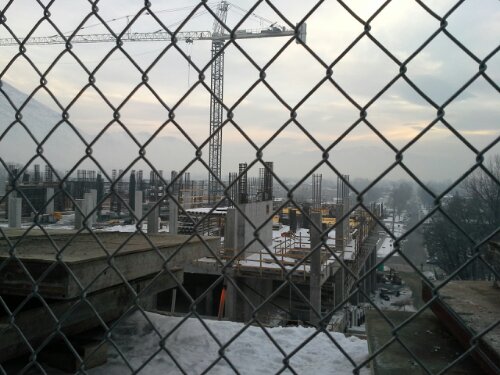Inversion. Many native or “naturalized” Utahns throw the word around all the time, but what exactly does it mean, and how is it different from smog?
Before coming to Utah, BYU students Michelle Grant and Nikita Chotoo had never experienced inversion in their respective island homes of Hawaii and Trinidad. Chotoo, a senior studying biology conservation, first learned how inversion works in her classes. The closest Grant, a psychology major, came to inversion was dealing with vog (volcanic smog).
“Where I grew up was just like here (Provo), with the mountains,” said senior Tiana Anderson of Pleasant View. “I know it (the inversion) is like a pot — it simmers in the valley. … I know about inversion because I’m a runner. I check whether it’s a red-air day on the Internet, if it’s okay to run outside or not.”
The analogy Anderson mentioned is commonly used to describe Utah’s inversion. It works like this: Provo is surrounded by mountains (the sides of the pot) which, when the weather is cold and still, tend to trap pollution under a layer of warm air like a pot lid. Normally, temperatures are lower at higher altitudes, but during inversion, cold air is left to fester in the valley, causing the air to actually feel warmer at higher altitudes. With nowhere to go, the pollution in the valley builds until either the ground absorbs enough heat to break up the inversion or strong winds blow the pollution out.
Inversion occurs during both summer and winter, environmental scientist Kent Bott explained, but it’s more consequential during the winter when the sun’s rays are too weak to heat the ground easily and snow’s white color reflects the radiation right back into space.
“Smog is the consequence of inversion. Inversion is a meteorological event,” said Bott, who works for the Utah Division of Air Quality. “That’s the basic difference. … Smog is all the junk that comes from car tailpipes, the salt we use on our roads, human activities like using a woodburning stove, and industries doing their thing. During inversion, smog gets trapped. It’s not static — it sloshes around a little — but it needs a horizontal wind, usually associated with a storm, to blow it out.”
Individually, the particles of smog are too small to see. The white, gray, brown or even yellow clouds of smog visible on bad air days can be seen because there are so many particles distorting the light. The Division of Air Quality monitors pollution and sends out alerts when the pollutant particles reach specific points, measured in micrograms of material per cubic meter.
The first alert comes at 12.5 µg/m3, when the DAQ asks people to stop using their woodburning stoves. At the second (25.5 µg/m3), people are required to stop woodburning. The air quality is deemed “unhealthy for sensitive groups” (older adults, people with respiratory problems, people exercising outside, and children) at 35.5 µg/m3 and unhealthy for everyone at 55 µg/m3. (A detailed nomogram of each air quality classification can be found on page 4 of the National Ambient Air Quality Standards for Particle Pollution.)
The state Department of Environmental Quality provides city-by-city air quality information at airnow.gov. Each stage of air quality (“Good,” “Moderate,” “Unhealthy for Sensitive Groups,” “Unhealthy for All,” “Very Unhealthy” and “Hazardous”) has an assigned color ranging from green to maroon.
So far this winter, Utah has had 24 “red air/unhealthy for all” days, 22 of which were in January alone.
“We haven’t had a winter like this since about 2005, so it’s been about seven years since we had inversions go so long,” Bott said. “Last year was too warm for long inversions, and the year before, we just got storm after storm, which cleared the air. Right now it looks like maybe we’ll get another inversion from Saturday to maybe Wednesday. I wouldn’t say this winter is worse than in the past, just different.”
Bott offered six tips for students seeking to avoid and/or reduce pollution:
- Stay indoors where the air is filtered as often as possible, especially members of the “sensitive” group (older adults, people with respiratory problems, people exercising outside, and children)
- Carpool or use public transportation rather than drive yourself; or, at least, consolidate car trips as much as possible because every time the engine cools down, it creates more pollution when it’s restarted
- Drive more slowly(“Cars emit more pollution between 55-60 miles per hour, and most of the places you go on a daily basis are close, so you don’t need to rush,” Bott said)
- If a car is sitting for more than 30 seconds with the engine running, shut it off — it’s better to restart it after the engine has cooled than to keep it running
- Use spiral bulbs instead of incandescent; they use less energy
- Take showers instead of baths; generally, people take a shorter time in the shower than in the bath, and the less hot water used, the less fossil fuels are used to heat it
“This is one of those things where everyone is affected,” Bott said. “Everyone has to breathe the air and if everyone does something, it makes a big difference. These are small things, but collectively they can have a big impact.”
 |
| A cloud of smog, trapped during Provo’s most recent period of inversion, hovers over buildings on the south side of BYU campus in this Jan. 23 photo. (Photo by Jessica Henrie) |
 |
| Students walk home from campus Jan. 23 in a cloud of smog, trapped in the valley by the inversion. (Photo by Jessica Henrie) |
 |
| Patches of clear sky are visible at the Alta Apartments in this Jan. 27 photo after a weekend storm began clearing the air in the valley. (Photo by Jessica Henrie) |






